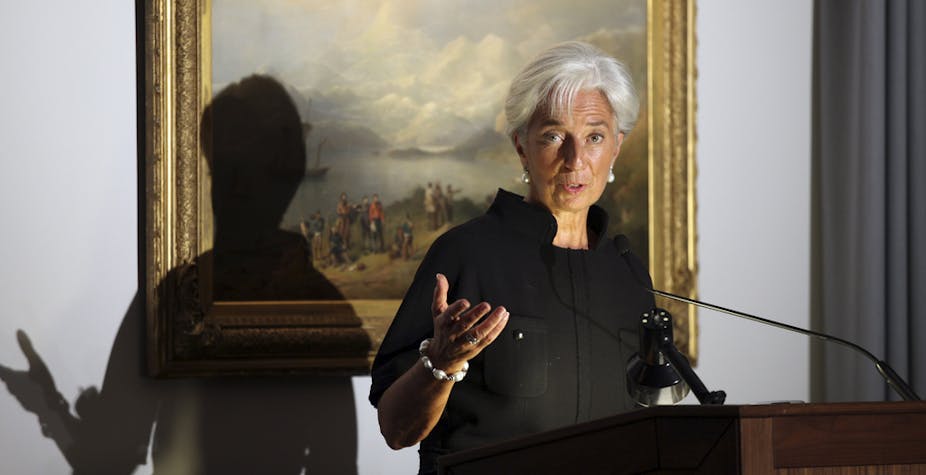Having clashed previously with governments over the wisdom of their austerity policies, few fireworks followed the publication of the International Monetary Fund’s World Economic Outlook on Tuesday. But a few fuses may have been freshly lit for investors trying to second guess the behaviour of the world’s central banks.
The IMF’s comments on faster growth in the US – in line with previous expectations – and upward revisions in UK and German growth forecasts got plenty of headlines. And we heard more warnings about the risks of deflation, especially in the eurozone. Meanwhile, emerging markets were told to prepare for higher interest rates and more volatile capital flows. Everyone was told to pull their socks up and get on with structural reforms to their economies, that old IMF chestnut. Nothing new, then?
Not exactly. With this report the IMF put itself firmly in the camp urging western central banks to keep their accommodative monetary policies in place. That is, the Fed and the Bank of England shouldn’t phase out quantitative easing or raise interest rates too quickly. This recommendation puts the IMF directly at odds with the expectations of many financial analysts. For example, prices of futures contracts imply that financial markets expect US interest rates to pick up from the summer of 2015 and then rise 200 basis points through to mid-2017. If this happens, it would mark the end of the era of easy money.
Slack and Inflation Risk
Why the divergence in view? Markets appear to believe central bank promises to progressively withdraw stimulus as national economies recover and before inflation picks up. At first blush this sounds reasonable, but there is many a slip between cup and lip. Cut back on monetary stimulus too soon and not only is there a risk of triggering another downturn and rising unemployment, but low inflation may give way to deflation reawakening one of the nightmares of the 1930s — so says the IMF.
Much turns on assessing how much slack there is in the economy and what drives expectations about future price increases, in particular the tipping point from low inflation to deflation. The IMF has much more to say about the former, not surprisingly given the fickle nature of expectations. Time and again the IMF asserts there’s plenty of slack in economies on both sides of the Atlantic.
The IMF points to an empirical measure known as the “output gap” to support their claims of abundant slack. This gap measures the difference between actual economic output and potential output, the latter being forecast from underlying economic trends — an output gap of, say, 2% of GDP means that an economy can grow by 2% before inflationary pressures intensify. In 2009, when the world economy tanked, the IMF estimated that the large industrialised economies’ output had fallen 5.7% below its trend. In 2014, the IMF forecasts that output gap will fall to 2.4% and then will shrink further to 1.7% in 2015.
Alas, comparing national differences in output gap doesn’t quite fit the fund’s story. According to IMF estimates, the UK’s output gap will fall to 1.7% this year and 1.1% next year which, if accurate, suggests there’s little slack left in the UK economy and that financial market expectations of rate rises by the Old Lady are probably right. In contrast, the IMF’s estimates for the output gap for the US are larger than that for the Eurozone, yet the IMF is more worried about deflation in the latter.
Shaky metrics
All of this makes you wonder whether the output gap is a reliable guide for policymaking. In its appendix the IMF admits that output gap estimates are “subject to significant margins of uncertainty,” which isn’t exactly reassuring. More worryingly, the impact of long-term unemployment, deskilling, and the rebalancing of national economies away from financial services and construction alter the true amount of slack available in ways that are hard to measure accurately. Of course, the IMF could be right for other reasons. Still was it wise to put a shaky metric at the centre of their argument?
Curiously, the sections of yesterday’s report on emerging markets leave the strong impression that the IMF doesn’t expect its advice to be heeded, as the following quote shows:
As advanced economies’ assets have become relatively more attractive, emerging market economies have experienced lower capital inflows and currency depreciation, and these trends could intensify…
Much of the urgency, as the IMF sees it, in emerging markets getting their houses in order turns on the threat of higher interest rates in industrialised countries. Without that threat, why act? Charitably, perhaps the IMF’s message to emerging markets really amounts to “prepare for the worst and hope for the best.”
In yesterday’s report the IMF staked out a positions flatly opposed to market expectations of the future course of US and UK monetary policy. If there’s a case for keeping easy money the IMF missed a chance to make it effectively. No wonder the markets aren’t buying it.

